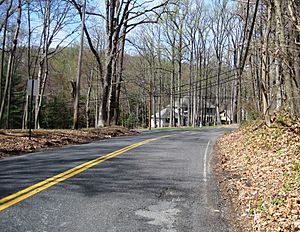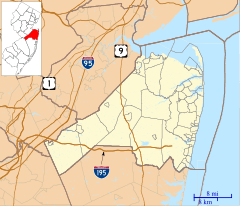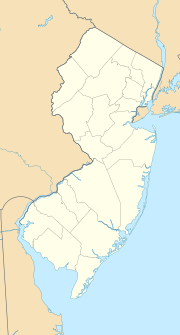Pleasant Valley, Monmouth County, New Jersey facts for kids
Quick facts for kids
Pleasant Valley, New Jersey
|
|
|---|---|

Intersection of Pleasant Valley Road and Reids Hill Road
|
|
| Country | |
| State | |
| County | Monmouth |
| Township | Marlboro |
| Elevation | 197 ft (60 m) |
| GNIS feature ID | 879364 |
Pleasant Valley is a small community located in Marlboro Township in Monmouth County, New Jersey. It's called an "unincorporated community" because it's a recognized place but doesn't have its own separate local government.
Legend says that George Washington himself named the area "Pleasant Valley" in 1777. The land here is quite hilly and covered with forests, with many homes spread throughout. Main roads like Pleasant Valley Road and Reids Hill Road connect the area to larger routes.
A long time ago, in 1665, the King of England gave a big piece of this land to a person named Rev. Obadiah Holmes. By 1690, Dutch families started settling here. At first, the main language spoken in Pleasant Valley was a type of Dutch called "Low Dutch."
Contents
Farming and Horse Racing History
Pleasant Valley began as a farming community. Farmers grew crops like apples and a special type of potato called "giant" potatoes. These potatoes were huge, about the size and shape of an American football! In 1916, farmers here harvested a record-breaking 100 barrels of potatoes per acre.
The area was also famous for its horse farms in the 1800s. A very well-known racing horse named George M. Patchen was born here in 1849. He was a "trotter," which means he ran in a special way. In 1860, he set a speed record for trotters.
Hunting in Pleasant Valley
In the 1950s, Pleasant Valley was a popular spot for pheasant hunting. This was because the Pleasant Valley Game Protective Association would release about 500 pheasants right before hunting season began. This practice continued until 1960.
Revolutionary War Conflicts
Pleasant Valley was a site of fighting during the American Revolutionary War. There were small battles between American patriots and groups loyal to the British, known as Tories and "Pine Robbers." British soldiers often came to the area to take hogs, cattle, and sheep back to New York.
In 1778, a farmer named Daniel P. Schenck was killed during an attack on his farm. After the attackers left, his wife bravely chased them and managed to kill one of them. Another fight happened on June 21, 1781. A soldier named Walter Hier was wounded in his right arm during hand-to-hand combat here. He later received a pension for his injury.
The community even had a four-pound cannon on a local farm. It was used as a signal gun. When the cannon fired, it meant the enemy was close, and local patriots knew to gather at a nearby farm to prepare for battle.
Schools in Pleasant Valley
- There was once a school called "The Pleasant Valley School." It was a one-room schoolhouse where a single teacher taught students from first to eighth grade. This teacher had many jobs, acting as the principal, teacher, janitor, and even a nurse for the children. The school building is no longer there, but it was located at the corner of Pleasant Valley Road and Reids Hill Road.
- Collier High School is located in Pleasant Valley today. It is a special high school for students with unique learning needs.
Historic Places
Pleasant Valley is home to several historic properties, some of which are very old.
- Old Kentuck: This historic house was built by Colonel Asher Holmes in 1770. It is now listed on the National Register of Historic Places. Even though it was changed a lot in the 1940s, it is currently in poor condition.
- Old Dutch Colonial House: Near Route 34, there is an old Dutch Colonial house built around 1700. Experts say it's one of the best examples of early Dutch architecture in Monmouth County.
In 1967, the New Jersey Historic Sites Division identified many other historic locations in Pleasant Valley, including:
- Luyster House
- Smock House
- Collier Estate
- Gordon House (parts built in 1750)
- Cox Farm
- Halloran Farm
- Pleasant Valley Schoolhouse site
- Schanck Farm
- Smock Farmhouse
- Reid Farmhouse
- Lake Farmhouse
- John Schanck House (built around 1697)
- Garret Schank House (built around 1690)
- Daniel Schanck House
- Embree House
- Schanck House
- Cannon Hill Farm
- Raymere House (built in 1753)
- Indian Log Schoolhouse
- Applegate Homestead
- John Holmes House
Historic Markers
- In 1971, a historic marker was placed on Pleasant Valley Road. It marks the barn where the famous trotter horse, George M. Patchen, was born. This marker was put there by the Pleasant Valley Historic Society.
- In 1967, the Daughters of the American Revolution placed another historic marker in Pleasant Valley. This plaque calls the area "The Hornets Nest." It explains that during the American Revolution, the British called Pleasant Valley the "Hornets Nest" because the local men constantly bothered them. They would capture British ships and seize British loyalists to exchange for American prisoners.
Interesting Local Events
- The Pleasant Valley Cup: In the 1930s, the area hosted the "Pleasant Valley Cup," a half-mile horse race. To enter, a horse had to come from a farm owned by a Monmouth County farmer. The winner received a trophy and $50.00!
- Plane Crashes: Pleasant Valley has been the site of two plane crashes:
- On June 29, 1932, a state trooper named Douglas Stender crashed his plane here. He was injured and lost sight in one eye.
- On November 16, 1939, Paul Tergis crashed his plane on a farm after its engine had trouble. Luckily, he was not injured.




